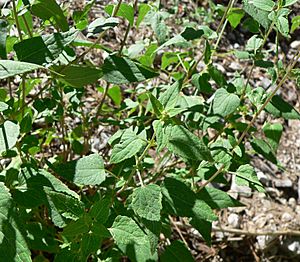Tasselflower brickellbush facts for kids
Quick facts for kids Brickellia grandiflora |
|
|---|---|
 |
|
| Scientific classification | |
| Kingdom: | |
| (unranked): | |
| (unranked): | |
| (unranked): | |
| Order: | |
| Family: | |
| Subfamily: |
Asteroideae
|
| Tribe: |
Eupatorieae
|
| Genus: |
Brickellia
|
| Species: |
B. grandiflora
|
| Binomial name | |
| Brickellia grandiflora (Hook.) Nutt.
|
|
| Synonyms | |
|
Synonymy
Brickellia umbellata (Greene) Rydb.
Coleosanthus congestus A.Nelson Coleosanthus garrettii Nelson Coleosanthus gracilipes Greene Coleosanthus grandiflorus (Hook.) Kuntze Coleosanthus minor (A.Gray) Daniels Coleosanthus petiolaris (A.Gray) Greene Coleosanthus populifolius Greene Coleosanthus umbellatus Greene Eupatorium grandiflorum Hook. |
|
Brickellia grandiflora, also known as the tasselflower brickellbush, is a type of flowering plant. It belongs to the daisy family, which includes many familiar flowers like sunflowers.
Contents
About the Tasselflower Brickellbush
This plant is a perennial herb. This means it lives for more than two years. It grows upright and can reach about 70 centimeters (about 2.3 feet) tall. Its stems usually have a few branches.
Where It Grows
The tasselflower brickellbush is found across a large part of western North America. You can see it in western Canada, including Alberta and British Columbia. It also grows in northern Mexico, in states like Baja California and Sonora.
In the United States, it is very common. It grows in the Rocky Mountains and areas west of them. This includes states like California, Oregon, and Washington. You can also find it in New Mexico, Texas, and the central Great Plains. This covers states like Nebraska, Kansas, and Oklahoma. It even grows in the Ozarks region of Missouri and Arkansas.
What It Looks Like
The leaves of the tasselflower brickellbush are interesting. They can be up to 12 centimeters (about 4.7 inches) long. They are often hairy and have glands, which might make them feel a bit sticky. Their shape can vary, appearing lance-shaped, triangular, or even heart-shaped.
Flowers and Fruits
At the top of its slender stems, the plant has groups of flower heads. These flower heads often nod downwards. Each one is a little over a centimeter long. They are surrounded by greenish leaf-like parts called phyllaries, which have tips that curl.
The flower heads are shaped like bells. Inside, they hold 20 to 40 small disc florets. These florets spread out like a fan. The plant blooms, or flowers, from July through September.
After the flowers, the plant produces fruit. The fruit is a hairy, cylinder-shaped achene. It is about 4 millimeters long. Each achene has a pappus, which is a group of bristles. These bristles help the fruit fly away in the wind, spreading the plant's seeds.
Plant Friends and Foes
Sometimes, a type of rust fungus called Puccinia subdecora grows on the tasselflower brickellbush. This is a natural part of the plant's environment.

